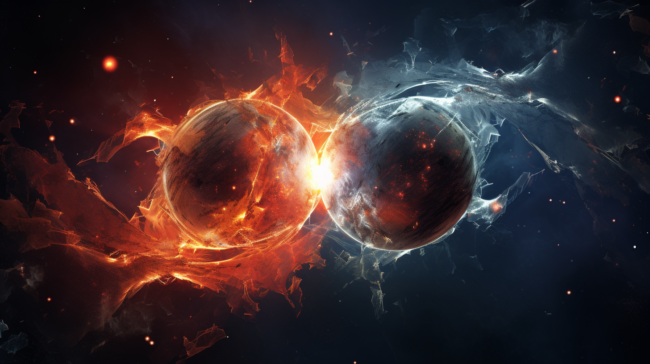
Introduction
In the fascinating world of physics, one concept that has intrigued scientists and the general public alike is antimatter. This elusive counterpart to the matter we interact with every day holds many secrets and potential applications that could revolutionize our understanding of the universe. In this post, we’ll probe the mysteries of antimatter, exploring its discovery, its role in the universe, and its potential applications.
What is Antimatter?
Antimatter is like the mirror image of matter. For every type of particle in the universe, there’s an antiparticle with the same mass but opposite charge. For example, the antiparticle of an electron (which has a negative charge) is a positron, which has a positive charge. When a particle and its antiparticle meet, they annihilate each other. They release energy in the process. This annihilation process is incredibly efficient. All of the mass of the particles is converted into energy, as described by Einstein’s famous equation, E=mc2.
The Discovery of Antimatter
The concept of antimatter first arose from Paul Dirac‘s equations in 1928. Dirac, a British physicist, was trying to reconcile the theories of quantum mechanics (which describes the behavior of very small particles) and special relativity (which describes the behavior of objects moving at or near the speed of light). His equations suggested the existence of particles with the same mass but opposite charge to known particles. Carl Anderson confirmed this prediction in 1932 with the discovery of the positron, or anti-electron. Anderson observed positrons in cosmic rays, high-energy particles from space that strike the Earth’s atmosphere.
Antimatter in the Universe
One of the great mysteries of physics is why the universe appears to consist of almost entirely of matter, with very little antimatter. According to our current understanding, the Big Bang should have produced equal amounts of matter and antimatter. So why do we see so much more matter than antimatter? This question, known as the matter-antimatter asymmetry problem, is one of the key unsolved problems in physics. Scientists have proposed several theories to explain this asymmetry, but none have been definitively proven.
- The Standard Model and CP Violation
The Standard Model of particle physics, while successful in many respects, does not provide a sufficient explanation for the observed matter-antimatter asymmetry. However, it does introduce the concept of CP violation. It refers to a discrepancy in the behavior of particles and antiparticles that could contribute to the asymmetry. While CP violation has been observed in certain particles, the effect is too small to account for the large matter-antimatter imbalance. - Baryogenesis and Leptogenesis
Baryogenesis theories propose that some processes in the early universe favored the production of baryons (particles like protons and neutrons) over antibaryons. Similarly, leptogenesis theories suggest a bias towards leptons (such as electrons) over antileptons. These theories often involve hypothetical particles and interactions not included in the Standard Model, making them difficult to test. - Multiverse Theories
Some cosmologists propose that our universe is just one of many in a multiverse. According to them, different universes have different amounts of matter and antimatter. In this view, it’s just a coincidence that we find ourselves in a universe dominated by matter.
Applications of Antimatter
Despite its scarcity in the universe, antimatter has some practical applications. In medicine, positron emission tomography (PET) scans use positrons to create detailed images of the body. When a positron and an electron in the body annihilate each other, they produce gamma rays that can be detected and used to build an image. In theory, we could also use antimatter as a source of energy or even for propulsion in space travel. But these applications are currently far beyond our technological capabilities.
The Challenges of Antimatter Research
Studying antimatter is not easy. Antiparticles are produced in high-energy environments, like particle accelerators, and require sophisticated equipment to contain and study. Because matter and antimatter annihilate each other on contact, storing antimatter is a significant challenge. Current methods of antimatter storage can only hold a tiny amount of antimatter for a short period of time.
Conclusion
Antimatter is a fascinating topic that touches on some of the deepest questions in physics. As research progresses, who knows what new insights and applications this mysterious substance might reveal? Despite the challenges, the study of antimatter offers the potential to deepen our understanding of the universe and could even revolutionize technology and medicine.


Leave a Reply